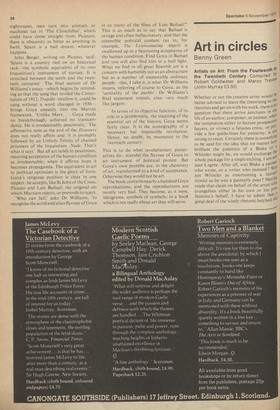The eye of the storm
Anthony Burgess
iz)Ya and the Impossible Revolution GWYn A. Williams (Allen Lane £7.00) SPain is the country where things have °Nays gone too far or, which is the same tiling, not far enough. Baroque, Sari Juan de la Cruz, the Inquisition, a savage Minoan sport that is also chivalric and metaphysical abn. d exquisite, the confrontation or symvi9sIs of hidalgo and pueblo, a statue of the r, "'gin Mary swathed in the ribbons of a 't,aPtaIn-general, fascism but also anarchism, tueoeentricity and anticlericalism, Castilian ,exts in Arabic script, Picasso, Goya. If ■ reland is England's bad conscience, Spain tisall Europe's. Whatever else it has been, „ nas never been bland. Now it is becoming 111(1, or middle-class. Watch Spanish !,'evision, read the periodical ABC. Spain as, until recently, capable of agony but orst a vulgarity. a ur Williams's book takes Francisco Goya a Witness for the agony, for pains which rnnlise to be birth-pangs but never are. a 18 not biography in the old sense (the °sIvellian way, for instance, which covers 1776 in detail without mentioning the Declaration of Independence); it is a retelling of the most agonising phase of Spanish history with Goya in the middle of it or watching it from exile, contained in it, never fully understanding it, doing only what an artist can do—recording particular agonies which are aspects of the bigger agony. As, for instance, in the engravings made during and after the war of 1808-14, generally known as The Disasters of War.
Nothing like these had previously been seen, in the art of any country. We may say that Hogarth and Rowlandson are behind them--in the sense that the medium is popular rather than aristocratic, also anecdotal, topical, even didactic. But England was England, comparatively bland, and had no Bonapartist occupation. All of us, however grudgingly, are to some extent Napoleon ists, and the only artistic cold douche our enthusiasm receives comes from Goya. Let Dr Williams remind us what the Disasters contain:
. . They shovel corpses into a pit, strip the dead, patch up the wounded, carry off the corpses of famine. We stand even closer as men are hanged; we can see their faces screw up, their tongues start from their heads. Men are spitted on tree trunks, dismembered, strangled; women are raped again and again, within touching distance. We look over a soldier's shoulder as he carves a sword into a man's groin.
As Dr Williams says, it might be now, it might be My Lai. What the uninstructed are never brought to appreciate is the universal behirid the sharp particular (Goya's French soldiers may be lethal machines, but the dying Spaniards are living individuals), that Goya is not just a Spanish witness for French brutality. The Spanish are brutal to each other; right and wrong are terribly mixed. Even the titles that Goya gives his engravings are ambivalent. The French and Spanish cut each other to bits with the caption Con razon o sin ella--'with reason or without', 'rightly or wrongly', 'for something or for nothing'. A rape is labelled No quieren—'they don't want to', 'they won't', 'they don't love'.
In 1799 Goya had produced the Capriehos —engravings that went to France to be studied by Delacroix, and to England (much later) to be burned in the street by Ruskin. The Ruskinian response was Spain's own, since these prints attacked priests and monks, 'superstitions' of all kinds, the sexual mores of the ruling class, the Inquisition. They are crammed with witches and
nightmares, men turn into animals or machines (as in 'The Chinchillas', which could have come straight from Picasso), there is obscenity as bitter as anything in Swift. Spain is a bad dream, whatever happens.
John Berger, writing on Picasso, said: 'Spain is a country tied on an historical rack—the symbolic equivalent of its own Inquisition's instrument of torture. It is stretched between the tenth and the twentieth centuries'. The final section of Dr Williams's essay--which begins by reminding us that the song that reviled the Constitution of 1812, Tragala: swallow it, could be sung without a word changed in 1936-brings Goya uneasily into the Marxist framework. 'Unlike Marx. . . Goya made no breakthrough, achieved no transcendence. He is irredeemably pessimistic.' The affirmative note at the end of the Disasters does not really affirm and 'it is promptly followed by an Unholy Trinity of chained prisoners of the Inquisition. Nada. That's what it says'. But all art tends to pessimism, meaning acceptance of the human condition as irredeemable; when it affirms hope it becomes propaganda. The equivalent in art to political optimism is the glory of form. Goya's religious position is clear in one respect : he accepts, like St John of the Cross, Picasso and Luis Bunuel, the original sin which Marxism rejects, or pretends to reject.
'Who can fail,' asks Dr Williams, 'to recognise the acrid and alien flavour of Goya
in so many of the films of Luis Bunuel?' This is as much as to say that Manuel is savage and often hallucinatory, and that the ostensible political content (as in, for example, The Exterminating Angel) is swallowed up in a heartening acceptance of the human condition. Find Goya in Bunuel and you will also find him in a bull fight. What we find in all great Spanish art is a concern with humanity not as an abstraction but as a number of memorable ordinary people -this, I take it, is what Dr Williams means, referring of course to Goya, as the 'centrality of the pueblo'. Dr Williams's final statement sounds, alas, very much like jargon : In terms of its objective function, of its role in a problematic, the meaning of the essential art of the historic Goya seems fairly clear. It is the iconography of a necessary but impossible revolution. Hence, no doubt, its resonance in the twentieth century.
This is to do what revolutionary posterartists do—transfer the flavour of Goya to an instrument of political protest. But Goya's own protests are, in the chemistry of art, transformed to a kind of acceptance. Otherwise they would not be art.
The book contains nearly a hundred Goya reproductions, and the reproductions are mostly very bad. They become, as it were, ideograms, symbols of symbols; in a book which is not really about art they will serve.



















































 Previous page
Previous page